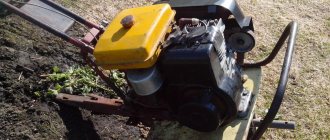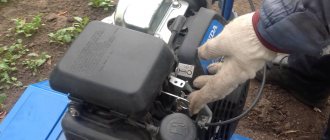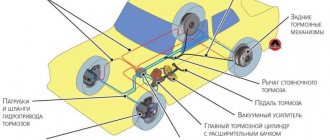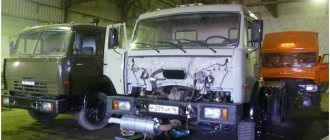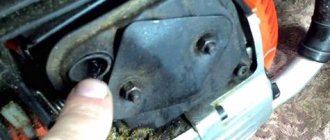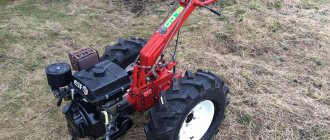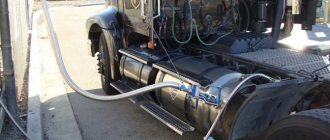- Main signs of failure to start the engine
- Reasons why the engine does not start
- What can be done, options for eliminating the cause
- Malfunction in detail by engine models
- Fault in detail by environmental class
- Malfunction in detail for the KamAZ model range
- Details by purpose
- A story from our repair practice
- KamAZ periodically stalls while driving
Symptoms of a problem
- Doesn't start with key
- Does not start from the starter (the starter turns, but does not start)
- The starter does not turn, the relay clicks (does not start)
- Won't start without gas
- won't start, no errors
- Not (tug)
- Suddenly stalled and won't start
- After replacing (repairing) the fuel injection pump, it does not start
- Doesn't start after replacing the ECU (control unit, brain)
- Won't start after major repairs
- Doesn't start, no error message on display
- After replacing the piston group it will not start
- The Kamaz truck crane does not start from the crane operator's cab (birdhouse)
- Starter makes noise when turning key
- The starter does not turn
- Doesn't start when cold (hard to start)
- Doesn't start when hot (hard to start)
- Check light on, won't start
- Stalled while driving, won't start
- Turned it off and won't start again
- Won't start without quick start
- Starts and stalls
- Won't start without pumping
- After drying out it won't start
- There is smoke coming out of the exhaust (white, black) and it won’t start.
- Dashboard doesn't work and won't start
- Smokes when cranking with starter
Second relay block
Scheme
p, blockquote 20,0,0,0,0 —>
p, blockquote 21,0,0,0,0 —>
Decoding
p, blockquote 22,0,0,0,0 —>
- power control relay after locking the instrument switch and starter
- instrument switch and starter relay
- battery switch relay
- brake signal relay
- reverse relay
- horn relay
- low beam relay
- high beam relay
- rear fog lamp relay
- fog light relay
- side light relay
Reasons why the KamAZ engine does not start
- Fuel system malfunctions
- Malfunctions of the electronic engine control system
- Mechanical engine problems
Fuel system malfunctions
- Failure of the high pressure fuel pump (HPF)
- Mechanical engine failure
- “Airing” of the fuel system
- Lack of fuel in the tank
- Faulty injection pump dispenser
- Won't start after replacing fuel filter
- Check valve failure
- Mechanical faults of injectors
- The injectors are pouring
- Lack or low pressure in the fuel system (fuel does not flow into the rail)
- Fuel filter clogged
- Clogged fuel lines
Malfunctions of the electronic control system
- Lack of contacts in electrical wiring connectors
- No supply voltage at the engine control unit
- Failure of the vehicle's main relay
- Ignition switch malfunction
- CAN bus break or short circuit
- Lack of “mass” (bad “mass”)
- Starter solenoid relay malfunction
- Engine control unit malfunction
- Starter solenoid relay malfunction
- Broken or shorted electrical wiring
- Damage to the relay and fuse box
- Ignition switch malfunction
- Starter malfunction
- Failure of the engine control unit
- Crankshaft sensor malfunction
- There is no power to the injectors (no pulse at the injectors)
Mechanical engine failure
- Engine jam
- Destruction (“spacing”) of the engine
- Damage to the flywheel drive disc
- Incorrectly set ignition marks
Relay box behind switch panel
p, blockquote 8,0,0,0,0 —>
Scheme
p, blockquote 9,0,0,0,0 —>
p, blockquote 10,0,0,0,0 —>
Purpose
p, blockquote 11,0,0,0,0 —>
- ABS relay
- Starter Interlock Relay
- Brake relay
- Clutch relay
- Fuel heating relay
- EFU relay
- Daytime running light relay
- Platform Stop Sensor Relay
- Rear fog lamp relay
- Oil separator relay.
What to do in this situation?
Diagnostics Kamaz
The KamAZ manufacturer tries to make the car reliable, but there are situations when suddenly the KamAZ car stalls and does not start.
First you need to determine how this malfunction manifests itself. There are two possible breakdowns:
- When you turn the ignition key, the starter turns the truck engine
- The starter does not turn on and does not turn the engine
If you find yourself alone in this situation with a faulty car, the main thing is not to panic. If the control system of the truck in question does not turn on the starter when turning the engine start key, then the cause of the malfunction lies in the electrical equipment or electronic systems of the vehicle. The cause of the breakdown may lie in both the electrical equipment of the car and the mechanics. Perform the sequence of actions indicated below.
Recommendations:
- Check fuses
- Check the presence of fuel in the tank
- Check the fuel filter for clogging and, if possible, replace it
- Visually check the condition of the electrical wiring
- Check the battery contacts and tighten them
- Try to start the engine using ether
- If you have completed all the steps and have not achieved a positive result, call the specialists at +7 (917) 555-00-05
Diagnostic sequence
There are no exact recommendations for the diagnostic sequence. If the engine stalls periodically, it is better to wait a little time and try to find out what the problem is. It is not difficult to determine a malfunction in the operation of an internal combustion engine - electronic diagnostic systems allow the electronic control unit to record problems. Verification methods based on visual and auditory observations should be kept in mind. The presence of extraneous noise, changes in the color of gas exhaust and other signs indicate a malfunction of the engine. Car owners with extensive driving experience know that minor faults lead to big problems - major engine repairs or complete replacement. Periodic inspections of parts and components of the unit, which are recommended to be carried out once a week, help to avoid such problems:
- check the level of engine oil and antifreeze;
- inspect for damage and ruptures of tips, connectors, hoses;
- monitor the operation of gaskets and seals.
Article on the topic: How to properly make a door shutter yourself
To determine the reason for the engine stopping at idle, you must:
- First, carefully examine the engine and the space under the hood (pay special attention to inspecting the wiring parts).
- Next, check the condition of the air and fuel filters (at the same time, check the level of liquids in the cooling and ventilation systems).
- Then warm up the engine to a high temperature, press the gas pedal - a change in the color of the exhaust gases to white, grey, gray or blue indicates problems in the internal combustion engine.
It wouldn't hurt to check the engine for various noises. To do this, it is better to use a stethoscope or a regular device made of a wooden stick with a small metal or plastic container attached to the end. This will help you hear how the engine works. In the process of studying sound, it will not be superfluous to determine how the engine sounds - ringing or dull.
In cases where it is not possible to solve the problem on your own, it is better to send the car to a service station.
KamAZ periodically stalls while driving
It’s an unpleasant situation when a car can suddenly stall in any unpredictable place and at any time while moving, and then start again. Upon arrival of the diagnostician, “as luck would have it,” the equipment will definitely start. It is not always possible to find such a malfunction using the error history. There are many stored errors, but it is impossible to determine which one is responsible for the specified malfunction. Reasons why a car may periodically stall:
- Electrical wiring defects
- Sporadic malfunction of the engine electronic control unit
- Damage to the relay and fuse box
- Ignition switch malfunction
- CAN bus break or short circuit
Fuse F1
Scheme
p, blockquote 23,0,0,1,0 —>
p, blockquote 24,0,0,0,0 —>
Description
p, blockquote 25,0,0,0,0 —>
- nutrition
- radio equipment
- ECU circuit wiring harness
- to fuse block F2
- dryer cable
- instrument and starter switch
- starter relay
- to fuse block F3 after the instrument switch and starter
- to fuse block F3 to the instrument switch and starter
- fuse 60 A
- fuse 30 A
Details on engine models
Cummins (Cummins)
OM457La (Mercedes)
- Gas engine 820.62-300
740 BOSCH MS6.1 (Electromechanical injection)
740 EDC7 Common Rail system
Possible fuel system problems
If the KamAZ Euro 4 does not start for a long time, the reason must be correctly determined. The fuel system must be checked. It is recommended to exclude problems with the following units:
- electric and mechanical fuel pump;
- injector;
- carburetor;
- fuel filters and lines.
Important! Sometimes the units remain in good working order, but clogging of the installed filters interferes with the operation of the power unit. In addition, violation of the basic rules for operating a car and its fuel will lead to undesirable consequences.
The engine can only operate properly if the fuel system meets standards and is of high quality. If the KamAZ Euro 3 engine does not start immediately and the fuel system meets the standards, the ignition devices are additionally checked. It is for this reason that it is extremely important to use high-quality fuel and carry out regular maintenance to extend the life of the vehicle.
Details on the model range
- KAMAZ-5360
- KAMAZ-4310
- KAMAZ-45144
- KAMAZ-53229
- KAMAZ-5322
- KAMAZ-6350
- KAMAZ-4350
- KAMAZ-ATZ
- KAMAZ-6560
- KAMAZ-44108
- KAMAZ-65207
- KAMAZ-4410
- KAMAZ-5460
- KAMAZ-53215
- KAMAZ-6522
- KAMAZ-4325
- KAMAZ-43114
- KAMAZ-45143
- KAMAZ-65221
- KAMAZ-5308
- KAMAZ-65206
- KAMAZ-54112
- KAMAZ-65201
- KAMAZ-45141
- KAMAZ-4528
- KAMAZ-65226
- KAMAZ-69361
- KAMAZ-5410
- KAMAZ-6360
- KAMAZ-54115
- KAMAZ-65225
- KAMAZ-43118
- KAMAZ-5320
- KAMAZ-65111
- KAMAZ-6520
- KAMAZ-5490 (NEO)
- KAMAZ-65115
- KAMAZ-5511
- KAMAZ-4308
- KAMAZ-5321
- KAMAZ-65117
- KAMAZ-4326
- KAMAZ-6550
- KAMAZ-4355
- KAMAZ-53504
- KAMAZ-65222
- KAMAZ-65116
- KAMAZ-53212
- KAMAZ-5350
- KAMAZ-43225
- KAMAZ-43205
- KAMAZ-53208
- KAMAZ-6580
- KAMAZ-43255
- KAMAZ-43253
- KAMAZ-53205
- KAMAZ-6540
- KAMAZ-53605
- KAMAZ-45142
- KAMAZ-55111
- KAMAZ-55102
- KAMAZ-6460
The starter does not respond to turning the ignition key: what to do - AutoExpert
Failure of one or another vehicle component/device forces the owner to take measures to eliminate this problem. Prompt troubleshooting largely depends on the effectiveness of such measures. In order not to aggravate the situation and save time and money, diagnostic measures in this case should not be spontaneous and unreasonable.
Any malfunction has a number of characteristic symptoms and manifestations. They should serve as a starting point in solving a specific problem. Let's consider a comprehensive diagnostic procedure in the case when the starter does not respond to turning the ignition key.
The battery is low
The vehicle's power supply system largely depends on the health of the battery. To keep it in working order, you must comply with a number of requirements and instructions. If, for some reason, the battery was not taken care of, then sooner or later such negligent attitude will come back to haunt the owner.
The most pronounced symptoms of a faulty battery are:
- low brightness of running lights;
- sound signal attenuation;
- presence of a red/white indicator on the battery cover;
- deflection of the on-board ammeter needle towards the charge when the starter circuit is closed;
- presence of sulfation at the battery terminals.
All these signs, one way or another, indicate that the battery needs diagnostics. First, you should check the level and density of the electrolyte. After this, the battery must be charged using a charger. If the battery is old, charging should be done at extremely low charging current values.
During this procedure, the battery can caps must be removed. During the entire charging time, you must ensure that the battery does not self-discharge. It happens that during charging one or more cans begin to “boil” before the rest. This phenomenon indicates that the battery, due to improper care, has exhausted its resource.
Ignition switch problem
The operation of some devices involves frequent movement of working elements. This functional feature leads to increased mechanical wear. Such devices include the ignition switch.
During long-term operation, its working elements may at some point cease to perform their functions. This malfunction is caused, first of all, by poor pressing of the contact group. This results in the engine not responding at all when the starter circuit is closed.
A problem with the ignition switch can be expressed as follows:
- interruptions in the operation of control indicators;
- The steering shaft does not come out of the lock.
Repairing a contact pair does not require highly professional skills. You can produce it yourself. As a rule, a layer of tin is soldered onto a worn surface, and the lock still serves faithfully for quite a long time.
Wiring
Often, difficulties with starting the engine are caused by mechanical or electrical damage to individual sections and associated wiring elements in the starter circuit. This leads to the fact that the starter is “silent”, no matter how diligently the driver closes the starter circuit with the ignition key. To identify such failures, you should use a tester and a test lamp.
: How to choose winter tires for a car
Diagnosis of this kind of problem requires a certain sequence of actions:
- inspection of contacts and connecting terminals for contamination/oxidation/poor contact of surfaces;
- checking the wires for breakdown using an ohmmeter;
- inspection of wires for damage to the integrity of the insulating coating.
A test lamp can be useful if there is a high probability that the stator winding of the electric motor has failed, or the brushes have become unusable.
Starter malfunction
As practice shows, most of the problems associated with starting the engine are directly related to the breakdown of the starter.
If, when you turn the key to the “Start” position, the starter does not manifest itself in any way, the reason for this may be:
- break in the coil of the solenoid relay;
- loss of elasticity of the relay return spring;
- failure of the starter relay (if present);
- mechanical damage to the solenoid relay;
- jamming of the Bendix drive fork.
Eliminating each of the presented reasons requires dismantling the starter, followed by disassembling and replacing the corresponding elements. The further sequence of assembling the device should be done in reverse order. It is important not to confuse the location of the underwater terminals.
Related article: How to find out the real mileage of a car when buying
A thick wire is connected to the starter power contact terminal, a thin wire is connected from the ignition switch to the “retractor” windings. The second “nickle” is connected to the stator winding of the motor.
Other reasons
In addition to the malfunctions presented, there are a number of factors that can cause such a malfunction.
- fuse break;
- starter relay failure;
- bad mass.
It is worth noting that the starter relay and the traction or retractor relay are two different devices. The starter relay is an auxiliary device that allows you to convert the current permissible for the ignition switch contacts into a high-power current necessary to start the starter.
KamAZ truck crane does not start
KamAZ truck crane does not start
Below is one of the cases from our repair practice. A truck crane based on KAMAZ Euro 3, manufactured in 2008, located at the Kuntsevsky car market. The starter turns, the car does not start. It stopped starting without any reason, the driver told us. Upon arrival, the technician checked the positives on the electronic engine control unit (MS6.1) and discovered a lack of power. I’ll say right away that this is a very common malfunction and that’s why we fix such breakdowns right away. It took the auto electrician exactly one hour to return the truck crane to working condition. The customer was very grateful to us for our efficiency and, to confirm this, generously paid for the repairs.
Kamaz 65115 Euro 3/4 fuses and relays
The Kamaz 65115 dump truck has been produced since 1995 with various Euro 3 and Euro 4 . In this article you will find a description of fuses and relays KamAZ 65115 class Euro 3 and Euro 4, as well as for all similar models KamAZ 4318, 5320, 65117, 6520, etc. by emission level, with block diagrams, their locations and photographs.
p, blockquote 1,0,0,0,0 —>
p, blockquote 2,0,0,0,0 —>
The purpose of fuses and relays may differ from those shown. Check the purpose with your documentation or diagrams on the back of the protective cover or inside the unit.
p, blockquote 4,0,0,0,0 —>
General layout of blocks
p, blockquote 5,0,0,0,0 —>
p, blockquote 6,0,0,0,0 —>
Description
p, blockquote 7,0,1,0,0 —>
- Relay box behind switch panel
- Fuse box (F2, F3, F4, F6)
- Second relay block
- Fuse F1
- Starter relay
- Alarm relay
- Wiper relay
- Relay - turn signal switch.
Diesel Injectors
Common rail injection technology has changed the face of diesel engines. Very precise, electronically controlled injectors make it possible to combine performance with relatively good exhaust gas purity. The manufacturing precision of nozzles must be enormous, at a level below one thousandth of a millimeter. During operation on fuel containing biocomponents and under the influence of high temperatures, the injectors wear out. First, the control valve depressurizes, and over time, the injector tip becomes calibrated.
How long it takes for everything to lead to an accident largely depends on the type of engine and the type of high-pressure equipment. Practice shows that, of course, the least durable injectors come from Delphi. There are cases that their breakdowns occur after 120 thousand kilometers (for example, Renault), while the most resistant (Denso, Bosch) are often able to withstand even a mileage of more than 400 thousand kilometers (for example, Opel Vectra). In some engines, the injectors bake themselves, and sometimes break off when removed. Then their dismantling by a specialist costs much more; here it is necessary to remove the cylinder head.
Symptoms of malfunction:
- diesel won't start or starts hard
- smoke from the exhaust pipe is black
- uneven operation of the power unit
- increased fuel consumption.
Repair of CR injectors: control valves, burnt coils, and used injection tips must be replaced (or repaired). Regeneration requires the use of an appropriate measuring device, and specialized services deal with this. New piezoelectric injectors have replaceable injection tips, but if serious failures occur, they usually cannot be repaired (only replaced with new ones).
Malfunctions of diesel models:
- Dacia Logan 1.5 dCi - has Delphi injectors that are extremely sensitive to fuel purity.
- Ford Mondeo III 2.0 TDCi - has a common rail pump that destroys the injectors.
- Ford Focus 1.8 TDCi - has Delphi equipment with a very limited service life.
- Jaguar X-Type 2.0 D - engine (Ford) is equipped with an unreliable high-pressure pump.
Turbocharger
The turbocharger provides the diesel engine with good performance, and draws its drive from the energy of the exhaust gases. And it is operation in the presence of very hot exhaust gases that causes most of the problems associated with turbocharger durability. Turbochargers are very sensitive to the quality of engine oil. A turbine rotor that rotates even several hundred thousand times per minute can get stuck if the oil does not “keep” the parameters.
The compressor wheel is so delicate that it can be damaged by sand penetrating the air filter. Sudden shutdown of the engine without cooling after a long drive causes, in turn, charring of the oil, coke formation and sticking of the turbocharger bearings. In turn, turbochargers with variable geometry really do not like slow driving, which causes the geometry system to be contaminated with carbon deposits.
Symptoms of malfunction:
- presence of oil in the intake system and exhaust gases
- turbocharger whistle
- engine switching to emergency mode
- increased engine oil consumption.
Turbocharger repair: It is technically possible to regenerate each type of turbocharger. Non-variable geometry turbochargers are easier and cheaper to repair, while variable geometry turbochargers are slightly more expensive to repair. Additional costs may arise if the "turbo" is electrically controlled.
How to make sure that the engine starts well when hot?
In such a situation, you need to act according to a certain algorithm, according to some instructions. The main task is to combine the mixture in order to allow the engine to start. To do this, when starting a hot engine, depress the gas pedal halfway, or even fully, depending on the situation and the carburetor itself. If you start pressing the gas frequently, you risk further aggravating the situation, because with each new press the pump will supply a new portion of gasoline to the carburetor, as a result you will simply “flood” the engine. Make several attempts, after starting, press the gas several times and continue your movement.
It would be better if he was silent or why Kuznetsov is smoking
The captain of Admiral Kuznetsov explained why his ship was smoking heavily: This is not a sign of any malfunction.
USS Freedom (LCS-1) There were also smoking Mistrals and some kind of Spanish aircraft carrier from World War II


